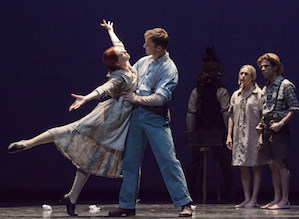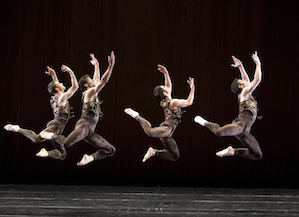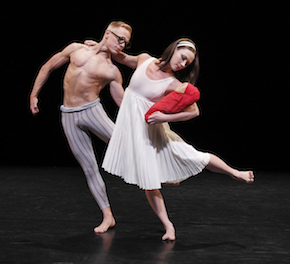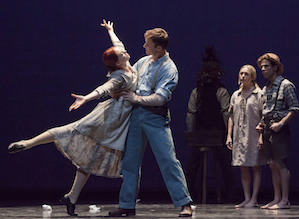
hoto by Jaime Young
The Paul Taylor Dance Company chose a dry and difficult path to open its five-day San Francisco Performances engagement Wednesday night at the Lam Research Theater. Beginning with a revival of the 1987 Kith and Kin, whose charms do not disguise its rigor, the show marched on to To Make Crops Grow, Paul Taylor’s acid vision of Shirley Jackson’s equally grim short story, The Lottery, which premiered during the troupe’s recent home season in New York. Even the glories of Taylor’s 1999 Cascade, revived this year and splendidly performed, couldn’t totally eradicate the melancholy.
To Make Crops Grow, set to movements 1,2 and 5 of Ferde Grofe’s Grand Canyon Suite, is abrupt and brutal, in sharp contrast to James Ingalls’ lovely sunrise lighting and folksy, salt-of-the-earth farm families, going about their day’s chore — collecting rocks. Hmm. Everyone’s pretty nice, capering around, except for one Young Wife (Parisa Khobdeh), a real grouch, married to an Elderly Husband (Michael Apuzzo, complete with potbelly). You know this isn’t going to end well for her.
Matters escalate when the Ritual Conductor (Robert Kleinendorst), wearing a pointy, scary, shamanistic chapeau, begins drawing lots from a black box perched on a three-legged stool. Taylor conducts us swiftly through riffs on iconic doomful dances, from repetitive stomps of Death in Kurt Jooss’ The Green Table to Khobdeh’s evocation of any of several Chosen Ones in various Rites of Spring set to Igor Stravinsky’s music (more on Taylor’s own version shortly). As the farm folk sigh in relief at not being chosen, the pool of possible victims gets smaller and smaller. Finally, the Young Wife gets what Taylor believes, or recently and somewhat jocularly said he believes, is coming to her.

Photo by Paul B. Goode
Kudos to the corps of families, charming, fresh-faced farmers who do what they can to lighten and confuse the proceedings before they gang up on the lottery loser. Khobdeh’s enactment of hauteur followed by flailing, abject terror is spot-on, and Kleinendorst’s wigwagging arms as he casts his spell are as frightening as his hat. The whole thing, just like Jackson’s story, feels like an incomplete scrap, offering a peek, nothing more, at humanity’s darkest side. If that was the intent, Taylor fulfilled it perfectly. What a bummer.
The 1987 Kith and Kin, created later than many of the masterpieces that are Taylor hallmarks, feels just a little academic. Set to Mozart’s Serenade No. 4, it never quite cuts loose. Not for want of trying. The parental figures, danced Wednesday night by Amy Young and James Samson, wear sober brown; their myriad young (nine, counting the marvelous, high-leaping soloist Heather McGinley) wear white. They polka; they introduce each other with little flourishes, arm and foot extended, they try minuets, interlacing arms; they pull themselves along the floor on their butts, they rise and chasse sideways.
The second movement begins with an evocation of classic modern dance. The couple in brown seem to care for each other, for the offspring and for the future of their art. They signal their devotion with gorgeous extensions, mirrored by the dancers in white. Taylor could have been thinking about what he and his longtime colleague Bettie de Jong, now rehearsal director, passed on to new generations. Perhaps they are the parental figures depicted here. If so, they’re not beyond encouraging the silliness that is truly Tayloresque; the “kids” stretch lengthwise on the floor, where they hop like toads, and they pair off, with one partner hanging onto the other — upside down.
Cascade, the most successful piece, is set to excerpts of Bach Concertos 4, 5, and 7 for piano and orchestra. The dancers, costumed by Santo Loquasto in rich brocade evocative of the Elizabethan era, are swift and daring, slow and sustained, and never less than dazzling. Of particular note was Amy Young’s solo in the Largo from Concerto No. 5. Her gracious port de bras filled the theater with a sense of exaltation. Michelle Fleet and Michael Trusnovec, in the Andante from Concerto No. 7, were sprightly yet courtly, pairing perfect jumps and devoted bows with charm and warmth.
Thursday night’s program had the wonderful arc that Wednesday’s lacked, beginning with the epic silliness of Gossamer Gallants (2011) moving on to the dark terrors of Last Look (1985) and ending with the 1980 Le Sacre du Printemps (The Rehearsal), Taylor’s brilliant interpretation of yes, Igor Stravinsky’s The Rite of Spring, now marking its centenary.
Each work made extraordinary physical and artistic demands, and all were answered in full. Dancer for dancer, Taylor’s is one of the best companies extant.
Gossamer Gallants, one of the choreographers many insect-inspired dances, offers as its backdrop Santo Loquasto’s dizzying firefly’s-eye view of dozens of castle towers. He also created the costumes: unitards in iridescent, shiny blue — with wings — for the men, and poison green for the women. The story is simple, savage and hilarious. First the males try to catch the females, gallantly spreading their wings as capes on the ground, Sir Walter Raleigh style, to no avail. Then the females turn the tables and get the males. Along the way, their hands thrusting like knives as they buzz here and there, the males, with James Samson and Sean Mahoney in the fore, ogle the females, jump and spin in midair; the females, led by strong and sultry Michelle Fleet, sashay and flirt, attacking with judo kicks when it seems unlikely that they can continue even standing upright, and dragging their captives away. Yes, you had to be there. Bedrich Smetana dances from The Bartered Bride were a perfect match for the frenetic state of affairs.

Photo by Paul B. Goode
Last Look, to music by Donald York, remains an enigma. The nine dancers — four men, five women — arecaught in an apocalyptic nightmare. Whether it is of their own making is open to conjecture, one of the things that makes the piece so compelling. The mirrors, tall panels spaced around the darkened stage, reflect and sometimes fragment the dancers, and, perhaps, whatever most frightens the people who watch them.
Alex Katz designed the sets and costumes — dark green jumpsuits for the men; long satin robes in orange, yellow and pink, plus shiny reflective jewelry, for the women. The movement language is pure frenetic Taylor, with palsied quivers of the extremities, terrified leaps and the sharpest of body torsions and contractions for all. The dance begins and ends in a state of nervous collapse, a human heap. Along the journey to the end, the dancers lean on each other, not so much for help as for what they can extract for an infusion that will let them survive. Perhaps they are suffering the wages of vanity. Maybe they’re zombies. Maybe they’re us. Among the standout artists were Michael Trusnovec, Michelle Fleet, Jamie Rae Walker, Aileen Roehl, and especially Amy Young, whose impending retirement will be a tremendous loss.
It is, of course, is a year of Sacres, but frankly Taylor’s is the one your reviewer most looked forward to seeing again. With his usual ability to confound expectation, Taylor created a work with dual and overlapping satiric scenarios, one in dance and the other in film noir, rendered like a cartoon. The score is Stravinsky’s two-piano arrangement of Le Sacre du Printemps. There are a dozen dancers, and the choreography puts them in fleet-footed, generally rigid profile, as if in tribute to Vaslav Nijinsky’s “lost” choreography for the 1913 Sacre, not to mention his still-extant Afternoon of a Faun.
Beautifully lit by Jennifer Tipton, John Rawlings’ set and costumes are in black, white and gray, with two notable, bright-red exceptions, a dance bag and the red baby blanket. These will loom large in the unwinding of the stories, and in the import of each. We’re looking at a playful yet heartfelt exegesis of what it means to be an artist, what it means to love something and lose everything, and, this being Taylor, the simple brutality of fate, chance and sometimes people.
If you spend a lot of time watching dance companies, you’ll probably be most struck by this one’s austerity and hierarchy, satirized yet also precisely rendered. The women are cultlike, in grey leotards and demure headwraps. Their deadpan Rehearsal Mistress (Heather McGinley) wears a towering hat that makes her look seven feet tall.
On the underworld side, Robert Kleinendorst’s mustachioed Crook moves like a stone-cold automaton. His Mistress, Amy Young, is a femme fatale from Chinatown. But in the midst of mass mayhem, it is his Stooge, Jamie Rae Walker, who, as she falls mortally wounded, accidentally stabs the baby on her way down. That human sacrifice sends the baby’s mother (Laura Halzack, as The Girl) into the wild frenzy that we have come to know or to imagine in every rendition of Rite of Spring. With its creation 33 years ago, Taylor gave an extraordinary and enduring new perspective to an honored classic.

